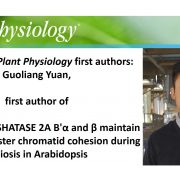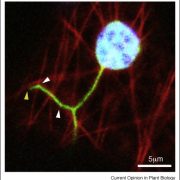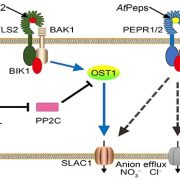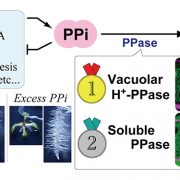
Plant Scientist Highlight: Barbara McClintock
Blog, Careers, Profiles of Plant ScientistsThis month we are featuring Barbara McClintock. She was at the cutting edge of her field and many of her discoveries weren’t accepted until years later. She has contributory greatly to the fields of genetics, ethnobotany, and paleobotany.
Dr. McClintock grew up as an independent and determined…

Assembling a Nanomolecular Power Station
The Plant Cell, The Plant Cell: In BriefThe ATP synthase complex of chloroplasts is an elegant example of the union of structure and function at the molecular level (Junge and Nelson, 2015). This enzyme complex consists of an integral membrane CFo component that transports protons and an extrinsic CF1 component that synthesizes ATP (Hahn et…

Recognizing Plant Physiology first authors: Guoliang Yuan
Plant Physiology, Plant Physiology: Author ProfilesGuoliang Yuan, first author of PROTEIN PHOSHATASE 2A B'α and β maintain centromeric sister chromatid cohesion during meiosis in Arabidopsis
Current Position: PhD student, Department Plant and Crop, Faculty of Bioscience Engineering, Ghent University
Education: Master of Landscape Architecture,…

Plants4Kids: By Anna N. Stepanova, North Carolina State University
Blog
Young children are curious by nature and their inquisitive minds are like sponges that take in everything that is happening around them. As a parent, a scientist, and an educator, I feel that my role is to teach children the basic rules of life in a fun and accessible way, while nurturing kids’…

Role of the Actin Cytoskeleton in Self-Incompatibility
Research, The Plant Cell, The Plant Cell: In a NutshellChen et.al. demonstrate that phosphatidic acid mitigates S-RNase signaling in pollen by stabilizing the actin cytoskeleton. Plant Cell (2018). https://doi.org/10.1105/tpc.18.00021
By Jianqing Chen, Peng Wang, Shaoling Zhang, and Juyou Wu
Background: The success of sexual reproduction in flowering…

All Roads Lead to Rome: Multiple Pathways Close Stomata in Plant Defense
Research, The Plant Cell, The Plant Cell: In a NutshellZheng et al. reveal that plant endogenous peptides and their receptors initiate stomatal closure to prevent microbes’ entry, thus enhancing plant immunity. The Plant Cell (2018) https://doi.org/10.1105/tpc.17.00701.
By Xiaojiang Zheng and Sheng Luan.
Background: Unlike animals, plants can’t…

Diterpenoid Defense in Host- and Non-host Disease Resistance in Rice
Research, The Plant Cell, The Plant Cell: In a NutshellLu et al. show that diterpenoids contribute to disease resistance in rice. Plant Cell. (2018). https://doi.org/10.1105/tpc.18.00205
Background: Rice (Oryza sativa) is an important food crop. Diseases caused by the fungal blast pathogen Magnaporthe oryzae and bacterial leaf blight pathogen Xanthomonas…

Maintaining Cellular Phosphate
Research, The Plant Cell, The Plant Cell: In a NutshellSegami et al. investigate cellular phosphate homeostasis in Arabidopsis. Plant Cell https://doi.org/10.1105/tpc.17.00911
Background: Many biological reactions, including the biosynthesis of DNA, RNA, proteins, and polysaccharides, produce inorganic pyrophosphate (PPi). However, accumulation of PPi…

What We're Reading: July 27th
WWR Full PostNews: CRISPR gene-edited plants subject to same restrictions as GMO plants
On 25 July, the European Court of Justice ruled that “Organisms obtained by mutagenesis are GMOs and are, in principle, subject to the obligations laid down by the GMO Directive,” and “The Court of Justice takes the view,…

